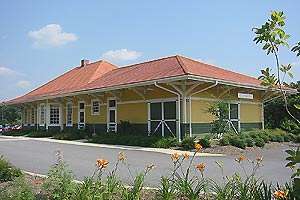Clemson station
Clemson, SC | |||||||||||
|---|---|---|---|---|---|---|---|---|---|---|---|
 Station building, built in 1916 and moved back from the right-of-way in 2001 | |||||||||||
| Location |
1105 Tiger Boulevard Clemson, South Carolina United States | ||||||||||
| Coordinates | 34°41′28″N 82°49′57″W / 34.6910°N 82.8325°WCoordinates: 34°41′28″N 82°49′57″W / 34.6910°N 82.8325°W | ||||||||||
| Owned by | City of Clemson | ||||||||||
| Line(s) | Greenville District | ||||||||||
| Platforms | 1 side platform | ||||||||||
| Tracks | 1 | ||||||||||
| Connections | Clemson Area Transit | ||||||||||
| Construction | |||||||||||
| Structure type | At-grade | ||||||||||
| Parking | Yes; free | ||||||||||
| Other information | |||||||||||
| Station code | CSN (Amtrak) | ||||||||||
| History | |||||||||||
| Opened | 1916 | ||||||||||
| Original company | Southern Railway | ||||||||||
| Traffic | |||||||||||
| Passengers (2013) |
5,597[1] | ||||||||||
| Services | |||||||||||
| |||||||||||
Clemson is a train station in Clemson, South Carolina. It is served by the Crescent passenger train of Amtrak, the national passenger rail service. The station sits on the corner of Calhoun Memorial Highway and College Avenue in the heart of downtown Clemson. Clemson is situated on one of the nation's emerging high-speed rail corridors, known as the Southeast High Speed Rail Corridor or SEHSR.
The station was originally erected by the Southern Railway in 1916. In the early 1960s, R.C. Edwards, then Clemson University president, convinced D.W. Brosnan, president of the Southern at the time, to prefer Clemson over Seneca as the main station for the area. On January 31, 1979, the Southern discontinued passenger service, turning operations of the Crescent over to Amtrak. In 2016 the station closed for construction on a nearby intersection. A Thruway Motorcoach will take Clemson passengers to Greenville.[2]
References
- ↑ "Amtrak Fact Sheet, FY2013, State of South Carolina" (PDF). Amtrak. November 2013. Retrieved 3 December 2013.
- ↑ Clarke Burns, Amy. "Q&Amy: Clemson Amtrak service to be interrupted". Greenville Online. Greenville Online. Retrieved 7 November 2016.